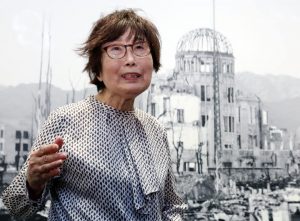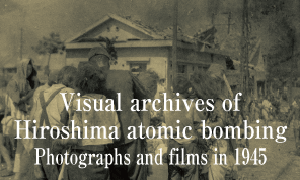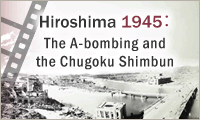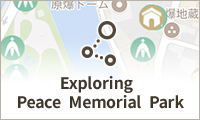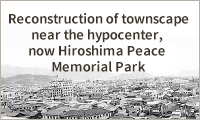One year after G7 Hiroshima Summit: Meeting’s results in question Interview with Keiko Ogura, A-bomb survivor who met G7 leaders
May 19, 2024
World learned about cruelty of nuclear weapons
Reversal of progress — “I sometimes feel resentment”
by Keiichi Nobira, Staff Writer
For the upcoming first anniversary of the summit meeting of the G7 (Group of Seven industrialized nations), which was held in Hiroshima in May last year, A-bomb survivor Keiko Ogura, 86, a resident of the city’s Naka Ward, agreed to an interview with the Chugoku Shimbun. At the time of the summit, Ms. Ogura met with the leaders from the participating nations at the Hiroshima Peace Memorial Museum, located in the city’s Naka Ward. “It was a first step for people around the world to understand what had happened in Hiroshima. Although it will take time, I hope everyone will do what they can,” said Ms. Ogura as she called for action toward the elimination of nuclear weapons.
What was the most impressive moment for you at the summit?
To convey the difference between conventional weapons and nuclear weapons to the leaders, I talked about my own experience in the atomic bombing and the story of Sadako Sasaki, the young girl who died of leukemia ten years after she had experienced the bombing at the age of two. After I spoke about the feelings of the parents who had lost their beloved daughter from radiation and the cruelty of nuclear weapons, the G7 leaders asked to shake my hand. They appeared speechless.
In fiscal 2023, visitor numbers to the Hiroshima Peace Memorial Museum hit a record high.
I think it was probably because people around the world became more aware of nuclear weapons. They must have wanted to pay a visit to the museum because the leaders of their nations had. In 2016, when then-U.S. President Barack Obama visited Hiroshima, there was an increase in numbers of students on school trips and families from the United States. Those children will have the chance to elect a president in the future. The challenge is how to convey our message to such children.
More people are making an effort to know about Hiroshima. But there are still many people in the world that are not trying to understand. It might be important to have them first learn about Hiroshima through the area’s local foods and specialty products.
What is your perspective about the recent movement in the international community that runs counter to the idea of “a world without nuclear weapons”?
More than feeling disappointment, I simply felt that things would have improved by now. Although slow, some progress has been made. I sometimes feel resentment, but I must continue making an effort. I am unable to express how grateful I feel seeing the Peace Memorial Park crowded with visitors. Due to a lack of humanity, wars happen even between nations without nuclear weapons. We must teach humanity to the world, for the sake of the victims.
Profile
Keiko Ogura
Born in Hiroshima City, Ms. Ogura experienced the atomic bombing in the area of Ushita-cho (now part of the city’s Higashi Ward), 2.4 kilometers from the hypocenter, when she was eight years old. After the 1979 death of her husband, Kaoru Ogura, who had served as director of the Hiroshima Peace Memorial Museum, she began to work as interpreter and coordinator for visitors arriving from overseas to Hiroshima around 1980. In 1984, she founded the Hiroshima Interpreters for Peace (HIP) organization.
(Originally published on May 19, 2024)

